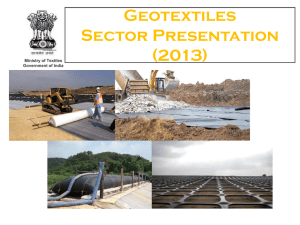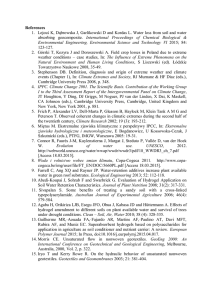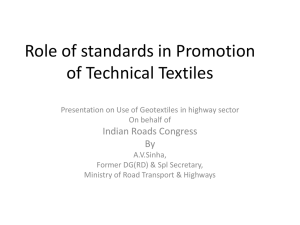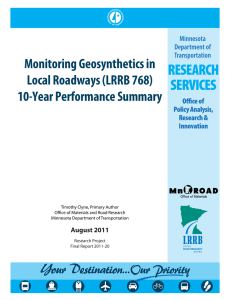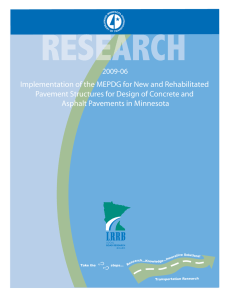TECHNICAL Using Geosynthetics to Improve Road Performance What Was the Need?
advertisement
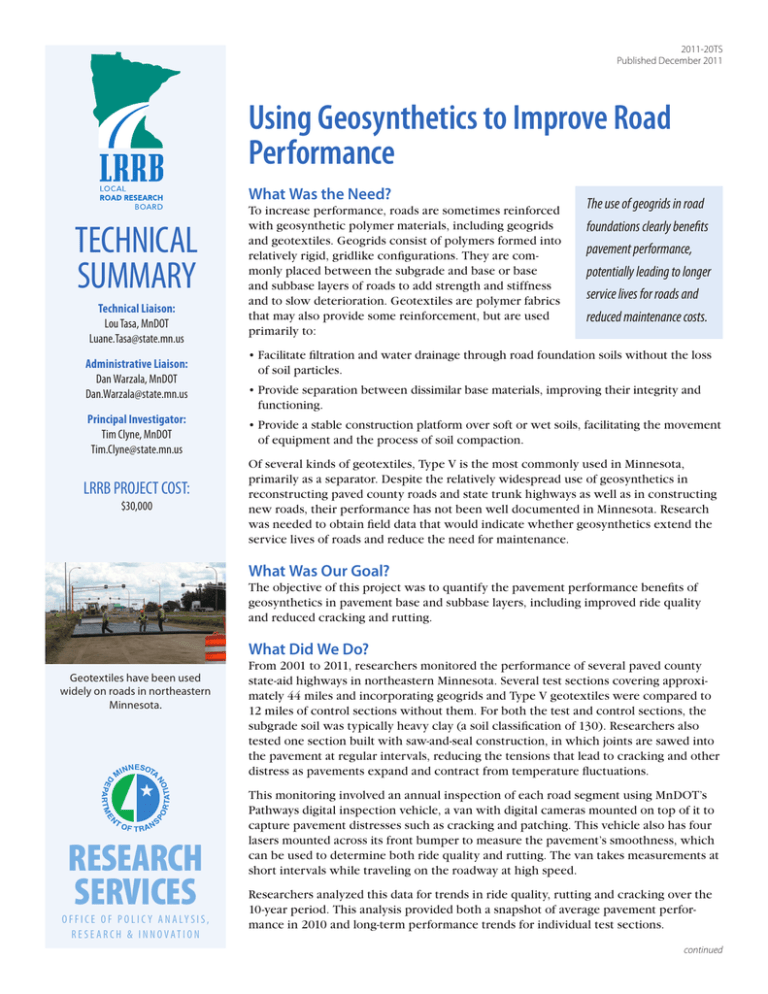
2011-20TS Published December 2011 Using Geosynthetics to Improve Road Performance What Was the Need? TECHNICAL SUMMARY Technical Liaison: Lou Tasa, MnDOT Luane.Tasa@state.mn.us Administrative Liaison: Dan Warzala, MnDOT Dan.Warzala@state.mn.us Principal Investigator: Tim Clyne, MnDOT Tim.Clyne@state.mn.us LRRB PROJECT COST: $30,000 To increase performance, roads are sometimes reinforced with geosynthetic polymer materials, including geogrids and geotextiles. Geogrids consist of polymers formed into relatively rigid, gridlike configurations. They are commonly placed between the subgrade and base or base and subbase layers of roads to add strength and stiffness and to slow deterioration. Geotextiles are polymer fabrics that may also provide some reinforcement, but are used primarily to: The use of geogrids in road foundations clearly benefits pavement performance, potentially leading to longer service lives for roads and reduced maintenance costs. • Facilitate filtration and water drainage through road foundation soils without the loss of soil particles. • Provide separation between dissimilar base materials, improving their integrity and functioning. • Provide a stable construction platform over soft or wet soils, facilitating the movement of equipment and the process of soil compaction. Of several kinds of geotextiles, Type V is the most commonly used in Minnesota, primarily as a separator. Despite the relatively widespread use of geosynthetics in reconstructing paved county roads and state trunk highways as well as in constructing new roads, their performance has not been well documented in Minnesota. Research was needed to obtain field data that would indicate whether geosynthetics extend the service lives of roads and reduce the need for maintenance. What Was Our Goal? The objective of this project was to quantify the pavement performance benefits of geosynthetics in pavement base and subbase layers, including improved ride quality and reduced cracking and rutting. What Did We Do? Geotextiles have been used widely on roads in northeastern Minnesota. RESEARCH SERVICES O F F I C E O F P O L I C Y A N A LY S I S , R E SE A R C H & I N N OVAT I O N From 2001 to 2011, researchers monitored the performance of several paved county state-aid highways in northeastern Minnesota. Several test sections covering approximately 44 miles and incorporating geogrids and Type V geotextiles were compared to 12 miles of control sections without them. For both the test and control sections, the subgrade soil was typically heavy clay (a soil classification of 130). Researchers also tested one section built with saw-and-seal construction, in which joints are sawed into the pavement at regular intervals, reducing the tensions that lead to cracking and other distress as pavements expand and contract from temperature fluctuations. This monitoring involved an annual inspection of each road segment using MnDOT’s Pathways digital inspection vehicle, a van with digital cameras mounted on top of it to capture pavement distresses such as cracking and patching. This vehicle also has four lasers mounted across its front bumper to measure the pavement’s smoothness, which can be used to determine both ride quality and rutting. The van takes measurements at short intervals while traveling on the roadway at high speed. Researchers analyzed this data for trends in ride quality, rutting and cracking over the 10-year period. This analysis provided both a snapshot of average pavement performance in 2010 and long-term performance trends for individual test sections. continued “This project shows that geosynthetics can be used to increase road performance, potentially leading to savings in maintenance costs.” —Tim Clyne, Research Forensic Engineer, MnDOT Office of Materials and Road Research “If roads are to perform well, it’s critically important that they have good foundations—and geosynthetics are one more tool to help accomplish this goal.” —Lou Tasa, Research Fellow, HumanFIRST Program, University of Minnesota Where geogrids (left) consist of polymers such as polyester or polystyrene formed into open grids that provide support, geotextiles (right) have the quality of woven fabrics, making them good solutions for facilitating separation, filtration and drainage. What Did We Learn? Results show that geogrids clearly benefit pavement performance, with test sections showing a better ride quality and surface rating than control sections. Surface rating is a composite measure of surface distresses including rutting and cracking. Test sections also had slightly less rutting than control sections, indicating an increased structural capacity. The saw and seal sections also had a better ride quality than control sections and an even higher surface rating than geogrid sections, but had more rutting than control sections. However, Type V geotextiles did not provide increased strength or better pavement performance, performing only as well as and sometimes worse than control sections. Test sections had more rutting and about the same ride quality and surface rating as control sections. While the use of Type V geotextiles did lead to less transverse cracking than in control sections, they exhibited more longitudinal cracking. Type V fabrics also had the most variation in performance, with some sections performing poorly and others well, whereas geogrid sections had a much more consistent performance. However, problems with this project, including problems with data for the project’s first few years, make these conclusions tentative and project specific. Knowledge of the use of geotextiles has advanced since these test sections were constructed, and more recent research projects have shown them to be beneficial. What’s Next? Based on these results, researchers recommend geogrids in situations where increased pavement strength or better pavement performance is needed. And while this project did not show increased performance for pavements with Type V geotextiles, recent developments in the use of geotextiles suggest that they can be beneficial for reinforcement and for separating fine from coarse materials. Produced by CTC & Associates for: Minnesota Department of Transportation Research Services Section MS 330, First Floor 395 John Ireland Blvd. St. Paul, MN 55155-1899 (651) 366-3780 www.research.dot.state.mn.us This Technical Summary pertains to the LRRB-produced Report 2011-20, “Monitoring Geosynthetics in Local Roadways (LRRB 768) 10-Year Performance Summary,” published August 2011. The full report can be accessed at http://www.lrrb.org/PDF/201120.pdf. For related studies, see http://www.lrrb.org/PDF/PP07GEOTS.pdf.

